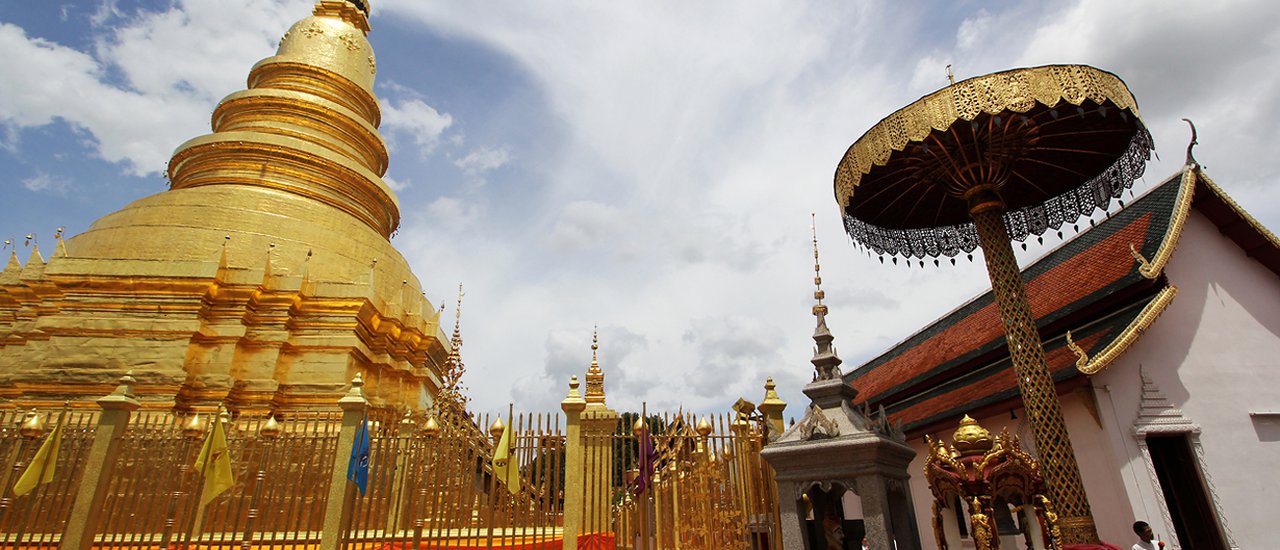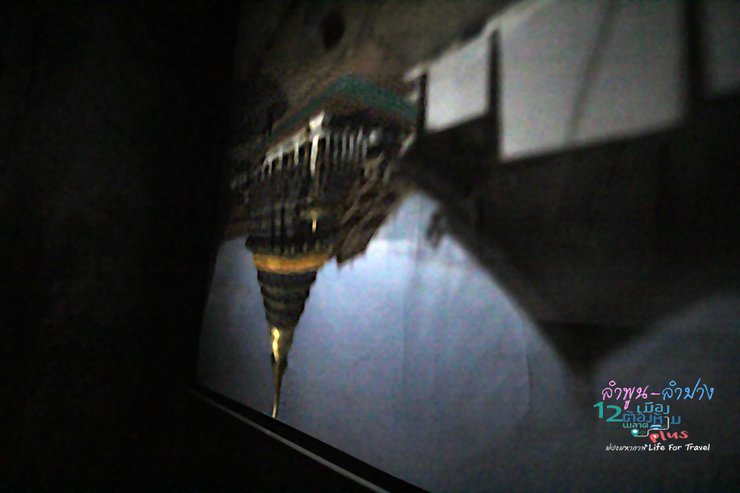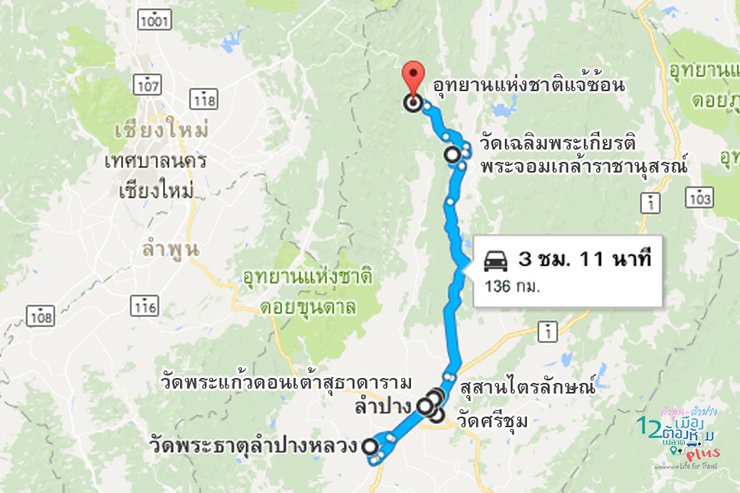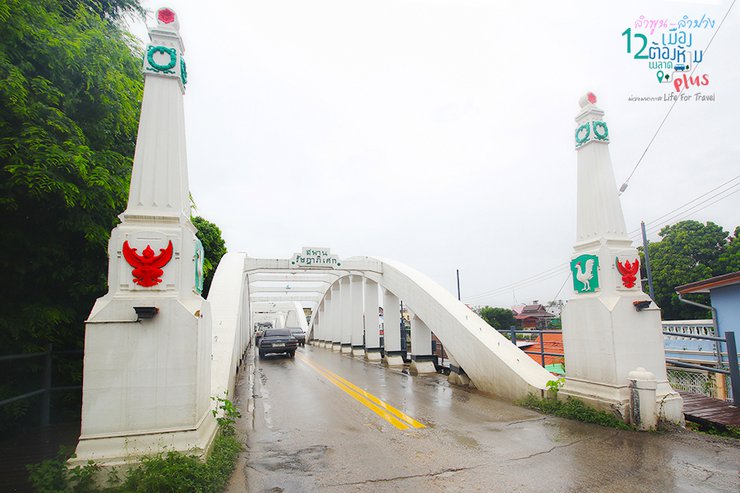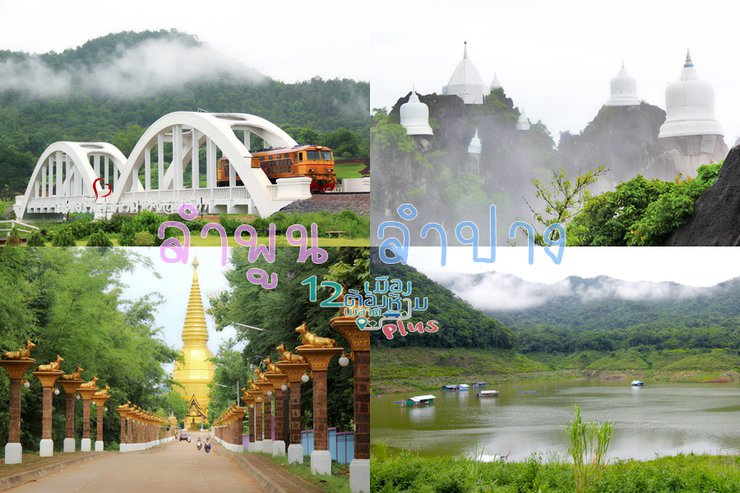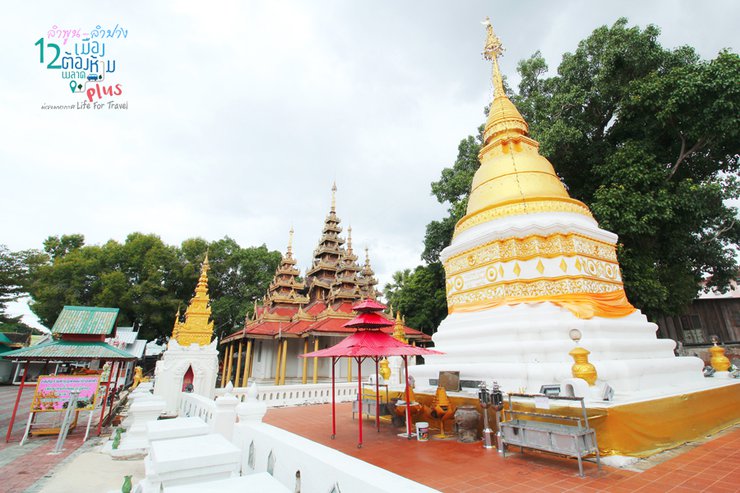Lush green rice fields, where farmers have just begun planting rice, are surrounded by rolling hills. The mist that hangs over the mountains slowly moves with the wind and rain. From the plains to the mountain peaks, visibility is limited to a few meters due to the dense fog. These are the enchanting charms of the rainy season in northern Thailand, which I always seek opportunities and time to experience.

This travelogue begins in the horse carriage city of "Lampang". The first thing that comes to mind when visiting Lampang is "Wat Phra That Lampang Luang". In front of the temple, we will see horse carriages lined up waiting for tourists. It is a unique and distinctive feature that is truly unlike any other province.

The Wat Phra That Lampang Luang, located approximately 18 kilometers from Lampang city, has held significant historical and cultural importance since ancient times. While the route to the temple passes through a somewhat developed urban area, the roads remain relatively uncrowded.

As you ascend the naga stairs and enter the temple gate, you will be greeted by the grandeur of the main stupa, along with the exquisitely crafted mandapa and viharn, which embody the architectural splendor of ancient Lanna.

Despite being a weekday, Buddhist devotees still flocked to pay their respects, driven by the power of faith. If you have the opportunity to visit Lampang, you should not miss this under any circumstances.


From the majestic Phra That Lampang Luang, I retraced my steps back into the city to explore various temples and tourist attractions located within close proximity. Before venturing further north, I paid a visit to Wat Chedi Phra That Chom Kitti and Jae Son National Park, respectively, as outlined in my itinerary.

Sri Chum Temple is another renowned ancient temple in Lampang province. Located on Thanon Thipphawan in Suan Dok Subdistrict, Mueang Lampang District, Lampang Province, the temple's unique architectural style immediately catches the eye, setting it apart from other temples.

The Sri Chum Temple, according to inquiries and research, is a Burmese-inspired temple. It houses a golden Burmese and Mon-style stupa containing sacred relics brought from Burma, which has long been revered by the people of Lampang.

Despite the march of progress and the encroachment of modernity, the heart of Lamphun retains its tranquil charm. Historic houses and exquisite ancient architecture stand preserved, offering a glimpse into the past for future generations.

For instance, the Rachaphruek Bridge, also known as the White Bridge, was built during the reign of King Rama V and has been continuously preserved and repaired to this day. It would not be an exaggeration to say that the White Bridge is one of the symbols of Lampang Province.

Another magnificent temple in the city of Lamphun, highly revered by the locals, is Wat Phra Kaew Don Tao Suchada Ram. Located in Wiang Nuea Subdistrict, Mueang Lamphun District, Lamphun Province, this temple boasts exquisite architecture and a rich history.

It is believed that northern Thai temples each house a principal stupa, similar to one another but distinct from those found in central Thailand. Northern temples tend to be older and are often located in close proximity, making it possible to visit several in a single day by bicycle.

Upon entering Wat Phra Kaew Don Tao, visitors encounter the grand Phra Borommathat Don Tao, a majestic stupa housing a relic of the Buddha's hair. The exquisitely crafted Burmese-style pavilion shelters a colossal Buddha statue, while the vihara enshrines a centuries-old reclining Buddha, a testament to the temple's ancient origins.

Not far from Wat Phra Kaew Don Tao is the Trairatan Cemetery, a place of great significance to the people of Lamphang. Upon arrival, one will see a large statue of Luang Pho Kasem Khemagko standing prominently at the front.

Luang Pho Kasem Khemagko was a highly respected monk in Lampang and throughout Thailand. He was a strict practitioner of Vipassana meditation and lived an austere life, unattached to material possessions or even a fixed residence. He spent his entire life practicing Dharma at the Trairatanaram Cemetery.

Following his passing on January 15, 1996, the revered monk's disciples across the nation were deeply saddened. His incorruptible remains are currently housed in a glass coffin within the Trailaksana Cemetery, allowing visitors to pay their respects and seek blessings during their visit to Lampang.


From the city, I traveled north to Jae Hom District to visit the Chelimphrakiat Phra Chom Klao Rachanusorn Temple. Now that the rainy season is in full swing, the rice paddies, where rice has just been planted, are surrounded by mountains. The mist that floats around creates a truly refreshing feeling.

Warm smiles and friendly greetings, hallmarks of Thai culture, are readily encountered in rural life. This welcoming spirit adds to the charm of travel in Thailand.


As dusk approached, we arrived at the site of Wat Chedi Luang Worawihan, a temple built to commemorate King Rama I. Due to the late hour, we decided to find accommodation nearby and ascend the temple the following morning. Numerous small resorts offering affordable lodging were available in the vicinity. The area, being a local community, provided convenient access to food and various shops.
To reach the top of Wat Chedi Phra Kiat Phra Chom Klao Rachanusorn, also known as Wat Phra Phutthabat Pu Pha Daeng, visitors must take a four-wheel drive vehicle operated by local villagers. The service is available at the foot of the temple for 100 baht per person. Personal vehicles are not permitted due to the steep and slippery road conditions. The first trip departs at 7:30 am on weekdays and 7:00 am on weekends.
After a 3-kilometer ride in a local's car, you will reach the upper parking lot of the temple. From there, it is an 800-meter walk to the viewpoint. The walking path involves climbing a winding, steep metal staircase. Exercise caution as the path is slippery and steep. It is advisable to bring drinking water.

Upon ascending the stairs, visitors will encounter the prayer hall, which serves as the primary vantage point. While no monks reside permanently on the premises, they do ascend to conduct prayers on significant religious occasions. Each morning, staff members ascend to maintain the cleanliness of the area and assist tourists.

From the prayer hall, we can see the town of Jae Hom, the rice fields, and the villages below. However, today the sky is overcast and thick fog covers everything, making it impossible to see anything.

From the prayer hall, if we turn our faces outward, the lower right-hand side will be as shown in the picture. The pagoda built on the top of the mountain is strangely beautiful.

From the same vantage point, looking towards the upper right-hand side, the distant silhouette of the Buddha's footprint can be seen. On days when the fog is thick, the atmosphere becomes particularly ethereal. The rainy season brings lush greenery to the trees and grass, creating a visually pleasing and refreshing environment.

Zooming in on the Buddha's footprint, there is a small staircase leading up. This is another viewpoint that offers 360-degree views, but extra caution is required when climbing as it is very steep and slippery.


From the pavilion, if you look to the left, you will see white pagodas lined up on the mountaintop, which is a major highlight of visiting Wat Chelimphrakiat Phra Chom Klao Rachanusorn.





We descended from the Wat Chedi Luang Worawihan temple in the late morning to travel to the Jae Son National Park, located in Jae Son Subdistrict, Mueang Pan District, Lampang Province, which is only about 20 kilometers away. The lush greenery and convenient transportation along the way made for a pleasant journey.

The main attraction of Jae Son National Park is its lush and scenic surroundings, characterized by abundant vegetation, nature trails, hot springs, Jae Son Waterfall, and mineral bath facilities.


Within the boundaries of Jae Son National Park, naturally occurring hot springs can be found almost everywhere. The water temperature is so high that eggs can be boiled in it, making it a truly remarkable natural phenomenon.


This morning, we will begin our journey in Lamphun Province. You may wonder why one should visit Lamphun after exploring Lampang. While I cannot answer that question definitively, my own experience suggests that a trip to Lampang is incomplete without a visit to Lamphun. The two provinces are incredibly close, and some attractions even span both regions. Our exploration will begin in Lamphun's city center, as indicated on the map.
There is no text to translate in the provided input. Please provide the text you want me to translate.

When visiting Lamphun, the first thing that comes to mind is "Wat Phra That Hariphunchai Wora Mahawihan". As soon as you step inside, you are immediately struck by the large number of Buddhist devotees, making the temple feel crowded. This may be due to the fact that it is a long holiday weekend during the Buddhist Lent period.

The golden stupa stands majestically as we enter the temple. Its shape resembles the Phra That Cho Hae of Phrae, both in size and beauty. Despite the hot weather and strong sunshine, many Buddhist devotees are walking around the stupa, demonstrating their devotion and faith in Wat Phra That Hariphunchai Woramahawihan.

Not far from Wat Phra That Hariphunchai stands the "Monument of Queen Chama Thewi".
The Queen Chama Thewi Monument is located in Nai Mueang Subdistrict, within the Nong Dok Public Park, approximately 1 kilometer from the Provincial Hall. It was built to commemorate Queen Chama Thewi, the first monarch of the Hariphunchai Kingdom. The Queen was a wise and virtuous ruler, possessing great courage and ability. She introduced Buddhism, art, and culture to this region, leading to its prosperity that continues to this day.

The area surrounding the Queen Chamadevi Monument is a beautiful public park, filled with flowers and shady trees, providing a relaxing space for the public to enjoy.

From the city center of Lamphun, I traveled to Wat Phra Phutthabat Tak Pha, which is about 20 kilometers away. The picture shows the path before reaching the temple, with lush greenery on both sides.

Wat Phra Phutthabat Tak Pha, located at the foot of a small hill in Makok Subdistrict, Pa Sang District, Lamphun Province, is another historical site that is revered by the people of Lamphun and the northern region.

Behind Wat Phra Phutthabat Tak Pha, a staircase leads to the Phra That Si Kru Ba, which is located on the mountaintop. Alternatively, visitors can drive to the top. The surrounding area offers panoramic views of lush greenery, villages, rice fields, and stunning landscapes.


From Wat Phra Phutthabat Tak Pha, I took Route 106 straight to Mae Ping National Park, located in Li District. The total distance from Lamphun city to Mae Ping National Park is about 130 kilometers. Tonight, we will be staying overnight at "Kaeng Ko," a scenic viewpoint within the park. We inquired about accommodation at the park, and they offered a room on a floating raft that can accommodate several people. However, since there were only two of us, the park officials charged us only 500 baht, which is very affordable. There is electricity, but it is turned off around 10 pm.

As the sun began its descent behind the mountains, casting a warm glow over the water, a friendly park ranger offered us a rowboat to reach the nearby floating restaurant. The restaurant, visible in the foreground of the image, serves delicious food, particularly their fresh fish dishes sourced directly from the surrounding waters. The prices are also quite reasonable.

The night was peaceful with the sound of rain falling most of the time. The atmosphere was quiet and private as there were not many tourists. Waking up to this kind of atmosphere, the air was cool and comfortable, with mist floating around. Thailand, you really don't know until you go, there are still many interesting places to visit.


This afternoon, I traveled from Kaeng Ko to Ko Luang Waterfall, which is also located within the Mae Ping National Park. The waterfall is only about 12 kilometers from Kaeng Ko, where we spent the night. Upon reaching the parking area near the waterfall, we had to walk a short distance of about 500 meters. The trail is not steep and easy to walk. The highlight of Ko Luang Waterfall is its clear emerald-green water. Even though it is the rainy season, the water level is not too high.


Departing from Mae Ping National Park, we continued our journey to the "Phra Maha That Chedi Si Wiang Chai," located just 15 kilometers away. It is said that if you visit Li District and do not come to this sacred land, it is as if you have not truly arrived in Li City.

The Sri Wiang Chai Maha Chedi is located in Na Sai Subdistrict, Li District. It resembles the Shwedagon Pagoda in Myanmar. It is the largest Lanna Buddhist architecture made of laterite in Thailand.
The construction of this monument was initiated by Luang Pu Kru Ba Chaiya Wongsa Phatthana with the aim of creating a stupa dedicated to the five Buddhas. It is intended to be the first such stupa in Thailand and the second in the world, offering a place of worship for Thai people.


Adjacent to the Phra Maha Chedi Si Wiang Chai temple lies Wat Phra Phutthabat Huai Tom. Before visiting this land, I heard that the villagers of Huai Tom do not eat meat and are very strict in their Buddhist beliefs. Most of the villagers here are Karen people who mainly work in agriculture and weaving. They do not even raise animals for food, except for dogs or cats. And it is true, as I have seen with my own eyes. This is a strange but good thing, with Wat Phra Phutthabat Huai Tom serving as the spiritual center of the community.



From Lamphun, I traveled back to Lampang, following the map. My primary destination was Doi Khun Tan National Park, a territory shared by the two provinces of Lampang and Lamphun.

I followed the original route, Highway 106, before turning onto Highway 1274 to reach Sa-rim-ngam District, Lampang Province. My destination was the Baan Mae Tam Craft Center, located approximately 40 kilometers away. Near the Craft Center is the Baan Mae Tam Farm, a model farm established to provide income opportunities for local hill tribe communities and to serve as an educational and recreational site for the public. The farm features a variety of flower gardens, strawberry fields, sheep breeding, cash crop cultivation, and agricultural product processing.

The staff guided us on a tour of the Mae Taem Farm, explaining its origins, processes, and various stages. Despite our brief visit, we gained a wealth of knowledge.

Just beyond the Mae Taem farm lies the Mae Taem Handicrafts Center. Although our visit was unplanned and it was a holiday, so no villagers were working, a staff member who oversees the center welcomed us and gave us a tour, explaining the center's history and purpose in a friendly manner. This left a positive impression on us.
Local officials explained that before the establishment of this center, the hill tribe villagers practiced slash-and-burn agriculture, cultivated opium, and engaged in deforestation and hunting. These activities led to a decline in their living standards. Recognizing these issues, Her Majesty Queen Sirikit initiated the creation of this center to provide the villagers with sustainable livelihoods and improve their quality of life. The center houses workshops where villagers can engage in various crafts, including weaving, basketry, woodcarving, and ceramic pottery.



This section showcases the work of local artisans, offering visitors a glimpse into their craftsmanship.


The front of the center will house a showroom where products will be sold to the general public at affordable prices.

From the Baan Mae Tam Arts and Crafts Center in Sa-ngam District, I traveled to Doi Khun Tal National Park, which straddles the border of Lampang and Lamphun provinces, a distance of over 90 kilometers. The road leading to the park headquarters is quite steep, but it is also shaded by trees and mountains. This land has a long and rich history.
The Doi Khun Tal National Park offers stunning panoramic views of the Lampang cityscape. The park features well-maintained and clean accommodation options for visitors. Additionally, it boasts extensive nature trails spanning several kilometers, providing opportunities for exploration and immersion in the park's natural beauty.


The Khun Tan Tunnel, located near the headquarters of Doi Khun Tan National Park, is the longest railway tunnel in Thailand. Construction began in 1907 and was completed in 1918, taking 11 years due to the lack of modern technology at the time. The transportation of construction materials was particularly challenging because of the dense forest and steep mountains.


Approximately 5 kilometers from the Khun Tan Tunnel lies the Tha Chomphu Bridge, also known as the White Bridge by locals. The Tha Chomphu Bridge was constructed just one year after the completion of the Khun Tan Tunnel. During this period, World War II was raging. Concrete, which is less flexible than steel, was used as the primary building material. However, due to the war, importing steel from other countries was impossible. As a result, concrete was used, and it was anticipated that the bridge might collapse soon. However, thanks to its well-designed structure, the Tha Chomphu Bridge has stood the test of time and remains standing today.


The surrounding area is decorated as a small, charming public park. There is no train station at this point, but in the winter, trains will stop here for tourists to get off and explore. This bridge, in addition to being a symbol of the railway, is also a place for relaxation in the evening for the people of Ta Chomphu and a popular photography spot for photographers in general.


In conclusion, I would like to express my gratitude to the Tourism Authority of Thailand for the "12 Unmissable Cities Plus" project, AVIS, Nok Air, and everyone who followed the stories of Lampang and Lamphun provinces. Until next time, goodbye.
There is no text to translate in the provided input. Please provide the text you would like me to translate.




Another travel destination in my style, Purple Mahakan, LIFE FOR TRAVEL https://www.facebook.com/PEESAT.PANTIP
ม่วงมหากาฬ
Tuesday, October 8, 2024 11:23 AM

